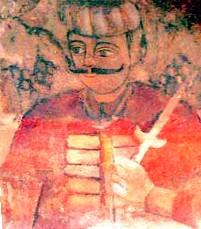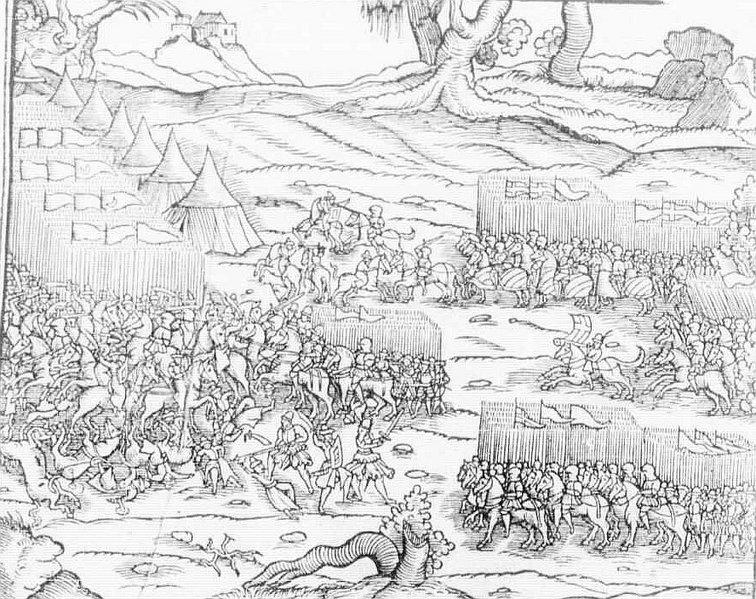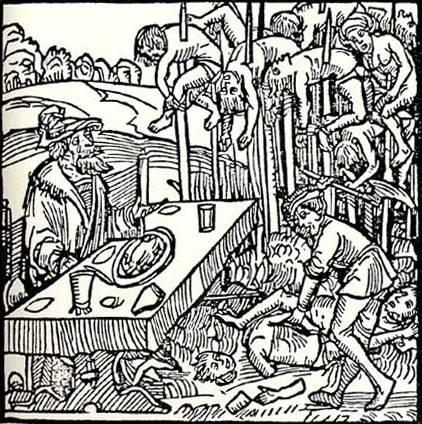to Cozia Monastery
Baiazid Ildirim (Baiazid “the Lightning”) came with the army of
approximately 40.000 soldiers to cross the Danube in Walachia, in order to hunt away
Mircea the Elder. Because he had a small army of only 12.000 soldiers, Mircea thought
that a battle in wide field would have been a real suicide for his army and chose to use the
tactics of harassing the Ottoman army during its road, weakening its strength. In the same
time, he tried to lead the enemy to a place where he could have more success.
8
Finally, he succeeded to attract the Ottoman army in a wooden and boggy place named
Rovine, where in 17th of May 1395, took place one of the greatest battles in the Romanian
history! After a long and bloody battle, Mircea the Elder succeeded to defeat the Ottomans,
obliging them to retreat over the Danube, with serious damages. This great victory over
such a force as the Ottoman Empire brought him the fame to all the other kings from
Europe! Later, in 1396 he participated to the anti-ottoman crusade organized by a part of
European kings, ruled by Sigismund de Luxembourg, King of Hungary. Because of some
strategically errors of western European rulers, the crusade had stranded in the fight in 25
September 1396, by being defeated by the Ottomans to Nicopole (at present, in Bulgaria).
During his reign, Mircea the Elder waged more struggles in 1397 and 1400 against the
ottomans in purpose to keep Walachia‟s independence. Moreover, Mircea the Elder has
even been involved in the domestical struggles from the Ottoman Empire against
Mahomed the First, supporting in turn more pretenders to throne as Mustafa Celebi (who
became sultan for a short period), Musa Celebi and Bedr Ed Din. The German historian
Leunclavius (1533-1593) had written about Mircea the Elder: “the prince among Christians,
the bravest and the most skilful”2. During his times, Walachia knew a prosperous age, great
economical development, good administration and army organization. He also had given a
great care of religion, building more churches and monasteries, the most famous being the
Cozia Monastery, built by the edge of Olt river. In fact, right in this monastery, he was
buried after his death in 31 of January 1418. After the death of Mircea the Elder, an age of
confusion and instability had begun in Walachia: there were many struggles for
government, disunions between the boyars, intrigues followed by all their bad
consequences as treasons, crimes, etc.
In those times, normally the ruler prince had unlimited jurisdiction, but in fact he had to
take in consideration the boyars opinions too, regarding both domestic and external policy.
The boyars were wealthy landowners that formed country‟s administration, but they were
not paid for this. Their main income came from the taxes levied to the paisants and simply
people. According to the succession system existed that age in Walachia, normally the
throne was inherited hereditary, but not by the law of primogeniture. The boyars had the
right to elect the prince from the various eligible members of the royal family. For many
years, the sons of Mircea the Elder have disputed the throne of the country against the
descendants of his brother, Dan, called Danesti. Therefore, more princes passed to the
throne of Walachia for 18 years but for short periods and with no important fulfillments.
2 Constantin C. Giurescu, “The History of Romanians” - Volume II, Part I, Bucharest, 1943
9

Meanwhile, the country has severely declined both economical and military and it
was soon subdued by the ottomans, which regularly robed it, pretended the annually tribute,
and often used it for their inroads in Transylvania.
1.2 Prince Vlad Dracul (1390-1447). One of Mircea the Elder‟s sons, Vlad, has
drawn back after his father death, to the court of Sigismund de Luxemburg, Emperor of
Germany and King of Hungary; Sigismund appreciated so much Mircea the Elder that in 8th
of February 1431, at Nuremberg Cathedral, received his son Vlad, among Dragon Order’s
Knights! In those times, only five kings in Europe were members of this order, so that
keeping the Dragon‟s Order ( Ordo Draconis- in latin), were a great honour! This Order was
symbolized by a golden medallion representing a coiled dragon with a cross above, whom
were written in horizontal: “Justus et pius” (Fair and faithful), and in vertical: “O, quam
misericors este Deus” (O, how merciful is God!)3. It is interesting to notice that Vlad have
not been a ruler yet, when he received the Order, a rare thing in that time!
Vlad lived for a while (1431-1435) in Sighisoara, a beautiful town in Transylvania,
waiting for the right moment to come his rights as Prince of Walachia. Sigismund of
Luxemburg approved Vlad to create here a mint, making coins
that have been used in both Transylvania and Walachia. The
mint allowed him to gather enough money, ensuring the
support on the way to the Walachia‟s throne. As the ruler of
Walachia in that time, Alexandru Aldea - one of the Mircea the
Elder‟s sons - was extremely subdued to turks, a group of
boyars went in 1436 to the King of Hungary, Sigismund of
Luxemburg, asking him to change Aldea with Vlad, the other
Vlad Dracul, Prince of
son of Mircea the Elder.
Walachia (1437-1447), fresco
Thereby, in April 1437, being supported by the Hungarian King, Vlad fulfilled his
dream and came to the throne of Walachia, occupied sometime by his glorious father.
According to the time‟s custom, because of his membership in the Order of Dragons, his
nickname became Vlad Dragonul. But as the word “dragon” is phonetically very close to
the Romanian word “drac”, (meaning “devil”), it was easier for Romanian people to call him
simple, Vlad Dracul instead of Vlad Dragonul. The suffix “ul” is in Romanian grammar the
masculine singular of the Definite Article, so that, as a forced appliance to the English
language, “Dracul” means “The Drac”. Vlad were a very calm and quiet person and did not
3 Neagu Djuvara, “From Vlad Ţepeş to the vampire Dracula”- Bucharest, 2003
10

emphasize by cruelty deeds, thus there were no reasons for the people to call him ” devil”.
Therefore, his nickname has nothing in common with the real sense of the Romanian word
“drac” but it was a popular chosen as a phonetically alternative to the word “dragon”.
Unfortunately, at his coming to the reign, he found the country in a very unhappy situation
at that time: already subdued by the ottomans, paying the annually tribute in money,
domestic animals (cows, sheep and horses) and children for the “ieniceri” corps of Ottoman
Turkish army. The “ieniceri” (janissaries) corps was created based on Christian children of
10-12 years, received as tribute, kidnapped from the countries subdued to Ottoman Empire,
or attacked during its campaigns (Walachia, Moldavia, Transylvania, Serbia, Rumelia (now,
Bulgaria), Hungary). These children had have grown in the Ottoman Empire in Muslim
religion and was military trained, so that at the age of 20 years they were ready to be
incorporated in the janissaries corps of the army. The janissaries‟ corps was famous in
Balkans as one of the most terrible corps of Ottoman army, its soldiers being very rough
and fanatics! Paradoxical, during the Ottoman military campaigns, these soldiers often
participated to the inroads even against their origin countries!
Coming back to the situation of Walachia, Vlad Dracul as a new ruler had to decide
if continued to subdue the country to Ottomans or opposed. According to the Byzantine
chronicler Dukas, Vlad Dracul together with 300 persons (boyars and soldiers) had gone to
Bursa town, Ottoman Empire. Here, he executed a peace treaty in which he ensured Murat
the Second, that he will not participate to military campaigns against him, will continue to
pay the tribute to Ottoman Empire and will ensure free road for Ottoman army though
Walachia, for its inroads against Hungary and Transylvania. This pact satisfied the Sultan
who did not need any disorders in this region, as he planned to conquer Hungary and
further Europe. However, considering later the country‟s interests, Vlad Dracul changed his
minds and passed to the Christians armies‟ side. In 1444, he aborted the peace treaty and
sent an army of 4.000 soldiers led by his
son of 16 years Mircea, for supporting the
Christian
Crusade,
started
against
Ottomans by the King Vladislav of
Hungary and Poland, together with Iancu
of Hunedoara, the ruler of Transilvania
(Romanian, as origins). In 10th of
November 1444, a great battle took place
in Varna (Bulgaria) where the Sultan
Murat the Second succeeded a better
strategically position, by occupying the hills Battle of Varna 1444- Polish chronicle from 1564
11
around the town. After the first struggle led by Iancu of Hunedoara, the Christians resisted
to the strong attacks of the Ottomans but soon, eager of glory and fame, the King Vladislav
ignored the advices of Iancu of Hunedoara to wait for the enemy‟s attacks and started
himself a rashly attack. The result was catastrophic for the crusaders: the Ottoman army,
more numerous and using the field‟s strategy not only rejected the attacks but also
succeeded to defeat the Christian army. During the battle, King Vladislav dropped down
the horse and has been recognized by a janissary soldier, who beheaded him. The
janissary raised victorious king‟s head in the lance‟s spike; when the Christian soldiers saw
that, began to panic themselves and to drop out in mess. Thus, the Ottoman Empire
obtained a great victory and this Christian Crusade, that expected to be revenge for the
defeat to Nicopole in 1356, had finished in a bad defeat.4 Vlad Dracul had participated
alongside Iancu of Hunedoara to more campaigns against Ottomans in the next two years.
Meanwhile Iancu of Hunedoara became King of Hungary, a very brave and wise military
ruler, who signified for many years, the Christian fight against Ottoman‟s expansion in
Europe. During his reign, Iancu of Hunedoara succeeded many victories over Sultan‟s
army and has been soon considered in Europe a symbol of anti-Ottoman struggle; his
victories assured for many years the quietness in the other European countries, frightened
by the possible Ottoman‟s invasion. Even if Vlad Dracul has supported Iancu of
Hunedoara in many battles, the Walachia‟s prince never gained his trust but more, in 1446
he fell in disgrace, suspected of establishing secret relationships with the Ottoman Turks!
At the beginning of 1447, Iancu of Hunedoara decided to hunt away Vlad Dracul
from the throne of Walachia, thus in November 1447 he came with the army and a new
ruler for Walachia, Vladislav II. There took place a fight but the army of Vlad Dracul did not
resist to the Transylvanians and has been soon defeated. Betrayed by a part of the boyars,
the walachian prince was cought together with his son Mircea, in the Balteni village and
killed: Vlad Dracul has been beheaded and his son Mircea was buried alive! Even he had
not the greatness of his father Mircea the Elder, Vlad Dracul had some attributes that
brought him respect and recognition from his contemporaries. Walerand de Vavrin, a
French duke, who participated in 1445 alongside Vlad Dracul to a military campaign in the
South Danube, has spoken about him as “very famous by bravery and wisdom”. The
Hungarian chronicle Bonifinius speaking about his army, said: “15.000 horsemen, of the
most redoubtable soldiers in the world!”5
4 Neagu Djuvara, “From Vlad Ţepeş to the vampire Dracula”- Bucharest, 2003
5 Constantin C. Giurescu, “The History of Romanians” - Volume II, Part I, Bucharest, 1943
12
Chapter II - VLAD ŢEPEŞ (1431-1476)
(Fragment)
…………………………………………………………………………………………………………..
2.2 Vlad Ţepeş and the merchants from Southern Transilvania. In all the
analysis of Vlad Ţepeş‟s reign, is allocated a special attention to the matter of his
relationships with the transilvanian merchants that, excepting few short periods was very
conflicting. In fact, the influence and connections of these merchants to the Hungarian
court together with their tricks to lay the things, will have later a big influence in the running
of Vlad Ţepeş‟s life, and to the stories that will be told later about him.
Southern Transilvania is a beautiful and pitoresque region of wooden hills, situated
in the center of present Romania, amazingly combining its quietly hills landscapes with the
greatness of craggy and massive Carpathian Mountains, rising the gorgeous Massifs of
Făgăraş, Piatra Craiului and Postăvaru. It is important to notice that, even if Transylvania
as region is often considered the entire western Romania, geographically Transylvania is
only the region inside the Carpathian Mountains arch! That is why after the Romans
conquered Dacia (the ancient Romanian country) in the II century, they gave its name: in
latin language, Trans means “over” and Silvania means “the country of forests”. Therefore,
the name Transylvania means, according to romans, “the country over the forests”. In the
XIII century, this region was colonized by Saxons brought from Prussia (present Germany)
in order to defend the South Eastern of Hungary. The most part of them settled here,
developing two important towns on the places of some ancient daco-roman settlements.
These towns are Sibiu or Hermannstadt (ger.) situated in Amlaş County and
Braşov, or Kronstadt (ger.) situated in Bârsa County. Due to their strategical positions and
to the fact they enssured the commercial and military connection between Walachia,
Transilvania and Hungary, these two towns have soon become the most importants in
Transylvania of the Middle Age. The transylvanian saxons had succeeded to develop here
great commercial centers, so that according to the documents, in 1353 the economical
activity in region became very prosperous. The craftsmen from region were organized in
„ guilds”, in 1376 only in Sibiu being known at least 19 guilds, but the most powerful guilds
existed in Braşov; these guilds included different craftsmen as goldsmiths, weavers,
locksmiths, drapers, coppersmiths, etc. The artisans from Braşov town were well known in
Transylvania but also in Walachia and Moldavia for the quality of their merchandises,
especially for the arms produced here. In fact, they dominated the commercial life in area,
13
between XIV and XVI centuries. Even it was obviously part of Transylvania country,
Southern Transylvania were entrusted for few times by the transilvanian princes, to the
protection of Walachian rulers. They have had done this as a proof of the trust they had put
in their southern neighbors, which they often helped to became rulers of Walachia. As soon
as Vlad Ţepeş took over the administration of Walachia, Iancu of Hunedoara, the King of
Hungary and Prince of Transylvania, entrusted him with taking care of the regions from
Southern Transylvania including also the two main towns, Sibiu and Brasov. Iancu of
Hunedoara even sent a letter to the merchandisers from these towns, advising them to
entrust in the new ruler of Wallachia, who will be their protector. In 3rd of July 1456, Vlad
Ţepeş concluded an agreement with the merchandisers from Braşov in which he promised
to defend them against a possible Otoman invasion. As a change, he demanded them to
give him shelter in any case of danger. In the same time, he continued to give them the
privilege to commercialize their merchandises in Walachia‟s markets. The relationships
between these two parts flew normaly until the autumn of 1456, when the saxons and
Hungarians instigated the people from Braşov to sustain a new pretender to Walachia‟s
throne, named Dan. Consequently, in 14th of February 1457 Vlad Ţepeş wrote a letter to
Braşov‟s merchandisers, protesting against their double-dealing, and claiming: “I did not
start this enmity….and I will hunt away Dan from Amlaş County”. This protest had had
effect, as the merchandisers stopped to plot against him, keeping good commercial
relationships with Walachia for one year more.
However, at the end of 1457, beginning of 1458, South Transylvanian people
supported again other new pretenders to Walachia‟s throne who intended to fight and exile
Vlad Ţepeş. These continous actions of supporting the different pretenders to Walachia‟s
leading, got angry Vlad Ţepeş who suddenly started in January-February 1458 a strong
campaign of bloody reprisals against the population of Southern Transylvania from Amlaş
County , Bârsa County and Făgăraş County. Matei Corvin, the son of Iancu of Hunedoara
(who died, meanwhile), succesor as King of Hungary and Prince of Transylvania,
supported Vlad Ţepeş in his campaign. He wrote to the transylvanian saxons
merchandisers on 6 March 1458: „ ...you are very guilty in this matter...cultivate peace with
this prince (Vlad) and his people”.6 Obviously, after all of these, the relationships between
Walachia and the saxons of Southern Transylvania essentially got bad and never were the
same again. In 1459, Vlad Ţepeş decided to change the former prerogatives conferred to
them and has forbidden the Transylvanian merchandisers to roam Walachia for selling their
goods. He ordered them to sell their goods in Walachia only once per year, in three fairs he
6 Ilie Minea, “ Vlad Ţepeş and his times”, Iaşi 1929
14

set up at the border with Transylvania. Here, they felt free to sell their goods to Walachian
merchandisers who will spread them further in the country. He took this decision for more
reasons: first, he considered that the old way of making commerce with the Transylvanians
was a beaten one, as the things had changed in Europe last time. In fact, the method of
“border fairs” commerce was used in most of Western Europe countries in order to protect
the indigenous merchandisers. Vlad Ţepeş considered also that allowing Transylvanian
merchandisers to do business all around Walachia like before, it was against the interests
of country‟s economy. Taking this decision, he intended to protect the walachian
merchandisers, as he had wanted to reorganize the trade in the country. On the other hand,
he needed a growing economy in order to prepare the future fights with the Ottomans for
Walachia‟s independence. Of course, this change was not on Transylvanian
merchandisers liking. Some of them ignored the new order of Vlad Ţepeş and continued to
sell their goods in Walachia; soon, 41 people of them together with their 300 servants -
among there were informers, too - were caught and impaled or burned alive!
In March 1460, the transilvanian saxons supported again the pretender Dan that
passed the frontier with an army, in his attempt to conquer Walachia, but in the struggle
that followed walachian army led by Vlad Ţepeş, defeated him. Than, Prince Vlad ordered
Dan to dig himself his own tomb; a priest made him the funeral service alive; afterward Dan
was killed and buried in the place of fight. Because they supported Dan in this attempt of
killing Vlad Ţepeş, the habitants of Amlaş County and Făgăraş County will have a lot to
suffer: in August 1460, Vlad Ţepeş has sent an army which as reprisals, has burned more
villages from these counties, impaling or beheading the most of the habitants. However, he
did not do badly to the citizens of Braşov town. In a
letter from July 1460, he ensured them to stay quite
regarding these reprisals because he will not touch
them: „ We have to settle accounts only with Amlaş and
Făgăraş Counties, our possesions”, he wrote. Because
their commercial interests were seriously affected by
Vlad Ţepeş‟s policy and their tumultuous relationship
with him, the Saxons merchandisers from Braşov town
did all their best to disparage him. As revenge, they
Vlad Ţepeş and his impaling
have chosen to spread everywhere they have gone,
victims- German engraving
bad rumors - most of them exaggerated - about his
deeds. They were urged by their leaders to tell everybody they met – commercial parteners
or unknown people - that “Vlad Ţepeş is a tyrant, a thirsty of blood devil; his only pleasure
15
is to impale innocent people; he use to party down to his impaled victims, etc.” In the letters
they sent to their Germanrelatives, the Transylvanian saxons often mentioned all these
things, more and more insistently. Based on all these exaggerated rumors, has appeared
few decades later in Germany, the well-known “German Stories” about Vlad Ţepeş‟s deeds,
most of them describing horrible things. For example, the german engraving above
suggests that Vlad Ţepeş used to “take the meal down the impaled victims”. Because there
are no other historically proofs to tell about his bloody deeds described in these stories,
there exists the opinion that some of them are purposely amplified and it is possible not to
be happened in reality. But as the oral communication always makes the stories to be more
exaggerated as long as they are told, these so called deeds of Vlad Ţepeş had spread all
over Europe. Thus, they have constituted the base of appearance after years, of the
legends that transformed Vlad Ţepeş in the well-known character, Dracula. Coming back to
the Saxons Transylvanian merchandisers, as you will see, their great influence in region
will prove to be decisive for the destiny of Vlad Ţepeş, in the later events. Nevertheless, I
will tell you about this on the right time!
…………?










